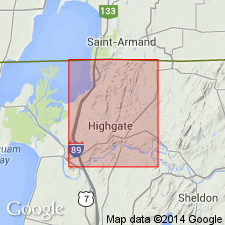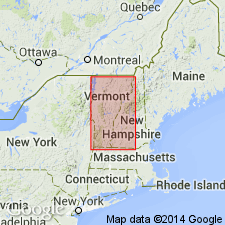
- Usage in publication:
-
- Hastings Creek formation
- Modifications:
-
- Named
- Dominant lithology:
-
- Limestone
- AAPG geologic province:
-
- New England province
Summary:
Named the Hastings Creek formation in northwestern VT. Name was applied to beds B2 and B1 of Logan's Philipsburg section of Quebec. McGerrigle mapped Hastings Creek formation in a small area in St. Albans quad. Thickness is 260 feet. Consists of white and dove-gray pure limestone with some magnesian beds (Logan's B1), and dark gray limestone with some magnesian beds (Logan's B2). The Hastings Creek is of Early Ordovician age or older(?).
Source: GNU records (USGS DDS-6; Reston GNULEX).

- Usage in publication:
-
- Hastings Creek limestone
- Modifications:
-
- Revised
- AAPG geologic province:
-
- New England province
Summary:
The Hastings Creek is revised to the Hastings Creek limestone of the Beekmantown group. Unit is combined on State geologic map with the Luke Hill and Naylor Ledge limestones east of the Philipsburg thrust. All three units are equivalent to the Bascom formation of the Beekmantown group. The Hastings Creek is of Early Ordovician age.
Source: GNU records (USGS DDS-6; Reston GNULEX).
For more information, please contact Nancy Stamm, Geologic Names Committee Secretary.
Asterisk (*) indicates published by U.S. Geological Survey authors.
"No current usage" (†) implies that a name has been abandoned or has fallen into disuse. Former usage and, if known, replacement name given in parentheses ( ).
Slash (/) indicates name conflicts with nomenclatural guidelines (CSN, 1933; ACSN, 1961, 1970; NACSN, 1983, 2005, 2021). May be explained within brackets ([ ]).

